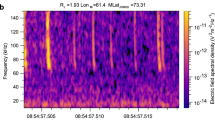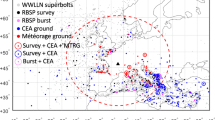Abstract
The detection1,2 of impulsive low-frequency (10 to 80 kHz) radio signals, and separate very-low-frequency (∼100 Hz) radio ‘whistler’ signals3,4,5 provided the first evidence for lightning in the atmosphere of Venus. Later, a small number of impulsive high-frequency (100 kHz to 5.6 MHz) radio signals, possibly due to lightning, were also detected6. The existence of lightning at Venus has, however, remained controversial7,8,9,10,11,12,13. Here we report the results of a search for high-frequency (0.125 to 16 MHz) radio signals during two close fly-bys of Venus by the Cassini spacecraft. Such signals are characteristic of terrestrial lightning, and are commonly heard on AM (amplitude-modulated) radios during thunderstorms. Although the instrument easily detected signals from terrestrial lightning during a later fly-by of Earth (at a global flash rate estimated to be 70 s-1, which is consistent with the rate expected for terrestrial lightning), no similar signals were detected from Venus. If lightning exists in the venusian atmosphere, it is either extremely rare, or very different from terrestrial lightning.
This is a preview of subscription content, access via your institution
Access options
Subscribe to this journal
Receive 51 print issues and online access
$199.00 per year
only $3.90 per issue
Buy this article
- Purchase on Springer Link
- Instant access to full article PDF
Prices may be subject to local taxes which are calculated during checkout




Similar content being viewed by others
References
Ksanfomality, L. V. Lightning in Venus' cloud layer. Cosmic Res. 17, 747–762 (1979).
Ksanfomality, L. V., Scarf, F. L. & Taylor, W. W. L. in Venus (eds Hunten, D. M., Colin, L., Donahue, T. M. & Moroz, V. I.) 565–603 (Arizona, Tucson, 1983).
Taylor, W. W. L., Scarf, F. L., Russell, C. T. & Brace, L. H. Evidence for lightning on Venus. Nature 282, 614–616 (1979).
Scarf, F. L., Taylor, W. W. L., Russell, C. T. & Brace, L. H. Lightning on Venus: Orbiter detection of whistler signals. J. Geophys. Res. 85, 8158–8166 ( 1980).
Russell, C. T. Venus lightning. Space Sci. Rev. 55, 317 –356 (1991).
Gurnett, D. A. et al. Lightning and plasma wave observations from the Galileo Flyby of Venus. Science 253, 1522– 1525 (1991).
Hunten, D. M. Venus lightning: Pros and cons. Adv. Space Res. 15, 109–112 (1995).
Grebowsky, J. M. in Venus II (eds Bougher, S. W., Hunten, D. M. & Phillips, R. J.) 125–157 (Arizona, Tucson, 1997).
Krasnopolsky, V. A. Lightnings and nitric oxide on Venus. Planet. Space Sci. 31, 1363–1369 (1983).
Hansel, S., Wells, S. A. & Hunten, D. M. Optical detection of lightning on Venus. Icarus 117, 345–351 ( 1995).
Borucki, W. J., Dyer, J. W., Thomas, G. Z., Jordon, J. C. & Comstock, D. A. Optical search for lightning on Venus. Geophys. Res. Lett. 8, 233– 236 (1981).
Sagdeev, R. Z. et al. Overview of VEGA Venus balloon in situ meteorological measurements. Science 231, 1411–1414 (1986).
Taylor, H. A. Jr, Cloutier, P. A. & Zheng, Z. Venus “lightning” signals reinterpreted as in situ plasma noise. J. Geophys. Res. 92, 9907–9919 (1987).
Gurnett, D. A. et al. The Cassini radio and plasma wave investigation. Space Sci. Rev. (submitted).
Uman, M. A. Lightning 272 (Dover, New York, 1969).
Pierce, E. T. in Lightning Vol. 1, Physics of Lightning (ed. Golde, R. H.) 351– 384 (Academic, London, 1977).
Brace, L. H. et al. in Venus (eds Hunten, D. M., Colin, L., Donahue, T. M. & Moroz, V. I.) 779–872 (Univ. Arizona Press, Tucson, 1983).
Brown, L. W. The galactic radio spectrum between 130 and 2600 kHz. Astrophys. J. 180, 359–370 ( 1973).
Sentman, D. D., Wescott, E. M., Osborne, D. L., Hampton, D. L. & Heavner, M. J. Preliminary results from the Sprites 94 aircraft campaign, 1. Red sprites. Geophys. Res. Lett. 22, 1205–1208 ( 1995).
Wescott, E. M., Sentman, D. D., Osborne, D. L., Hampton, D. L. & Heavner, M. J. Preliminary results from the Sprites 94 aircraft campaign, 2. Blue Jets. Geophys. Res. Lett. 22, 1209–1212 ( 1995).
Acknowledgements
The research at the University of Iowa was supported by NASA through the Jet Propulsion Laboratory.
Author information
Authors and Affiliations
Corresponding author
Rights and permissions
About this article
Cite this article
Gurnett, D., Zarka, P., Manning, R. et al. Non-detection at Venus of high-frequency radio signals characteristic of terrestrial lightning. Nature 409, 313–315 (2001). https://doi.org/10.1038/35053009
Received:
Accepted:
Issue Date:
DOI: https://doi.org/10.1038/35053009
This article is cited by
-
Parker Solar Probe: Four Years of Discoveries at Solar Cycle Minimum
Space Science Reviews (2023)
-
Cassini Exploration of the Planet Saturn: A Comprehensive Review
Space Science Reviews (2020)
-
Lightning detection on Venus: a critical review
Progress in Earth and Planetary Science (2018)
-
Composition and Chemistry of the Neutral Atmosphere of Venus
Space Science Reviews (2018)
-
Initiation of a lightning search using the lightning and airglow camera onboard the Venus orbiter Akatsuki
Earth, Planets and Space (2018)
Comments
By submitting a comment you agree to abide by our Terms and Community Guidelines. If you find something abusive or that does not comply with our terms or guidelines please flag it as inappropriate.



